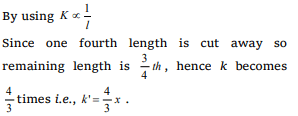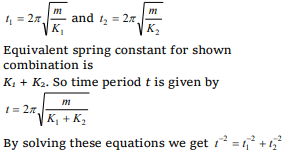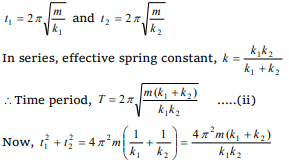1.The effective spring constant of two spring
system as shown in figure will be

a) \[k_{1}+k_{2}\]
b) \[k_{1}k_{2}/k_{1}+k_{2}\]
c) \[k_{1}-k_{2}\]
d) \[k_{1}k_{2}/k_{1}-k_{2}\]
Explanation:

2. A mass m attached to a spring oscillates every 2
sec. If the mass is increased by 2 kg, then timeperiod
increases by 1 sec. The initial mass is
a) 1.6 kg
b) 3.9 kg
c) 9.6 kg
d) 12.6 kg
Explanation:


3. A mass M is suspended by two springs of force
constants \[k_{1}\] and \[k_{2}\] respectively as shown in the
diagram. The total elongation (stretch) of the two
springs is

a) \[\frac{mg}{k_{1}+k_{2}}\]
b) \[\frac{mg\left(k_{1}+k_{2}\right)}{k_{1}k_{2}}\]
c) \[\frac{mgk_{1}k_{2}}{k_{1}+k_{2}}\]
d) \[\frac{k_{1}+k_{2}}{k_{1}k_{2}mg}\]
Explanation:

4. The frequency of oscillation of the springs shown
in the figure will be

a) \[\frac{1}{2\pi}\sqrt{\frac{k}{m}}\]
b) \[\frac{1}{2\pi}\sqrt{\frac{\left(k_{1}+k_{2}\right)m}{k_{1}k_{2}}}\]
c) \[2\pi \sqrt{\frac{k}{m}}\]
d)\[\frac{1}{2\pi}\sqrt{\frac{k_{1}k_{2}}{\left(k_{1}+k_{2}\right)m}}\]
Explanation:

5. If a spring has time period T, and is cut into n
equal parts, then the time period of each part will
be
a) \[T\sqrt{n}\]
b) \[T/\sqrt{n}\]
c) nT
d) T
Explanation:

6. One-forth length of a spring of force constant K is
cut away. The force constant of the remaining
spring will be
a) \[\frac{3}{4}K\]
b) \[\frac{4}{3}K\]
c) K
d) 4 K
Explanation:

7. A mass m is suspended separately by two
different springs of spring constant K1 and K2
gives the time-period t1 and t2 respectively. If
same mass m is connected by both springs as
shown in figure then time-period t is given by the
relation

a) \[t=t_{1}+t_{2}\]
b) \[t=\frac{t_{1}t_{2}}{t_{1}+t_{2}}\]
c) \[t^2=t_1^2+t_2^2\]
d) \[t^{-2}=t_1^{-2}+t_2^{-2}\]
Explanation:

8. Two springs of force constants K and 2K are
connected to a mass as shown below. The
frequency of oscillation of the mass is

a) \[\left(1/2\pi\right)\sqrt{\left(K/m\right)}\]
b) \[\left(1/2\pi\right)\sqrt{\left(2K/m\right)}\]
c) \[\left(1/2\pi\right)\sqrt{\left(3K/m\right)}\]
d) \[\left(1/2\pi\right)\sqrt{\left(m/k\right)}\]
Explanation:

9. Two springs of constant k1 and k2 are joined in
series. The effective spring constant of the
combination is given by
a) \[\sqrt{k_{1}k_{2}}\]
b) \[\left(k_{1}+k_{2}\right)/2\]
c) \[k_{1}+k_{2}\]
d) \[k_{1}k_{2}/\left(k_{1}+k_{2}\right)\]
Explanation:

10. A particle at the end of a spring executes simple
harmonic motion with a period t1 , while the
corresponding period for another spring is t2 . If
the period of oscillation with the two springs in
series is T, then
a) \[t= t_{1}+t_{2}\]
b) \[t^{2}=t_1^2+t_2^2\]
c) \[t^{-1}=t_1^{-1}+t_2^{-1}\]
d) \[t^{-2}=t_1^{-2}+t_2^{-2}\]
Explanation:

